#india pays tributes
Explore tagged Tumblr posts
Text
ICMEI Celebrates 75 Years of India-Argentina Relations and Pays Tribute to Libertador General San Martín

Noida: In a celebration marking the 75th anniversary of bilateral relations between India and Argentina and the commemoration of Libertador General San Martín, Dr. Sandeep Marwah, President of Marwah Studios, extended heartfelt congratulations on behalf of the International Chamber of Media and Entertainment Industry (ICMEI) to His Excellency Mr. Mariano Caucino, Ambassador of the Argentine Republic, Mrs. Barbara Paula Urdampilleta, and the people of Argentina. Speaking on this auspicious occasion, Dr. Marwah highlighted the strong and enduring relationship between India and Argentina. “India and Argentina have a history of robust and growing relations that are founded on mutual respect and shared cultural values. We are proud to celebrate this milestone together and look forward to many more years of fruitful collaboration,” said Dr. Marwah. Dr. Marwah also emphasized the significance of the Indo-Argentina Film and Cultural Forum under the auspices of ICMEI. “As we commemorate this important occasion, it is with great enthusiasm that we announce the Indo-Argentina Film and Cultural Forum is poised to reach new heights. This forum will serve as a vital platform to enhance our cultural exchanges and deepen the artistic and cinematic ties between our two nations,” he added. The Indo-Argentina Film and Cultural Forum aims to facilitate collaborations in the fields of cinema, media, and the arts, strengthening the cultural bond between India and Argentina. Through this initiative, ICMEI seeks to create opportunities for filmmakers, artists, and cultural ambassadors from both countries to collaborate, share knowledge, and celebrate each other’s rich heritage. Noida: In a celebration marking the 75th anniversary of bilateral relations between India and Argentina and the commemoration of Libertador General San Martín, Dr. Sandeep Marwah, President of Marwah Studios, extended heartfelt congratulations on behalf of the International Chamber of Media and Entertainment Industry (ICMEI) to His Excellency Mr. Mariano Caucino, Ambassador of the Argentine Republic, Mrs. Barbara Paula Urdampilleta, and the people of Argentina.
Speaking on this auspicious occasion, Dr. Marwah highlighted the strong and enduring relationship between India and Argentina. “India and Argentina have a history of robust and growing relations that are founded on mutual respect and shared cultural values. We are proud to celebrate this milestone together and look forward to many more years of fruitful collaboration,” said Dr. Marwah.
Dr. Marwah also emphasized the significance of the Indo-Argentina Film and Cultural Forum under the auspices of ICMEI. “As we commemorate this important occasion, it is with great enthusiasm that we announce the Indo-Argentina Film and Cultural Forum is poised to reach new heights. This forum will serve as a vital platform to enhance our cultural exchanges and deepen the artistic and cinematic ties between our two nations,” he added.
The Indo-Argentina Film and Cultural Forum aims to facilitate collaborations in the fields of cinema, media, and the arts, strengthening the cultural bond between India and Argentina. Through this initiative, ICMEI seeks to create opportunities for filmmakers, artists, and cultural ambassadors from both countries to collaborate, share knowledge, and celebrate each other’s rich heritage.
#ICMEI Celebrates 75 Years of India-Argentina Relations and Pays Tribute to Libertador General San Martín#Dr. Sandeep Marwah President of ICMEI
0 notes
Text

Let us pay tribute to all members of the CRPF for their bravery, devotion, and patriotism. #CRPF #india #indianarmy Shiv Pratap Singh
#Let us pay tribute to all members of the CRPF for their bravery#devotion#and patriotism.#CRPF#india#indianarmy Shiv Pratap Singh
0 notes
Text
F1 paddock pays tribute after former Force India deputy chief Bob Fernley passes away aged 70
Formula 1 President and CEO Stefano Domenicali has joined in paying tribute to Bob Fernley, the former Deputy Team Principal of Force India, who has passed away at the age of 70. Fernley worked for decades in both Formula 1 and IndyCar and Can-Am, as well as holding the role of Chairman of the FIA Single-Seater Commission from 2020 to 2022. Commenting on Fernley’s passing, Domenicali said: “I am saddened to hear the news that Bob Fernley has passed away. He was such an important part of Formula 1 and his love and passion for the sport will live forever. My thoughts are with his family and friends at this very sad time.” Former Force India driver and current Alpine racer Esteban Ocon added his own words of condolence on social media, writing: “Sad to hear about the passing of Bob Fernley today. "He was a great person and leader, and I was lucky enough to work and learn from him during my days at Force India. Sending my thoughts and condolences to his family and friends.” Meanwhile, former F1 racer turned pundit Karun Chandhok also paid tribute to Fernley, writing on Twitter: “Very sad news about Bob’s passing. Been a tough battle for him for the past few months but he fought it with typical pragmatism and strength. Our deepest condolences to his wife Audrey and their family.” via Formula 1 News https://www.formula1.com
#F1#F1 paddock pays tribute after former Force India deputy chief Bob Fernley passes away aged 70#Formula 1
0 notes
Text

An unprecedented female monarch in her dynasty, Rudrama Devi (r.1262-1289) presided over an age of prosperity. A successful warrior queen, she triumphed over both internal and external threats.
Her father’s heir
Rudrama Devi was the daughter of King Ganapati Deva (r.1199-1262) of the Kakatiya dynasty, who ruled over parts of present-day Telangana and Andhra Pradesh in Southern India. Their capital was located at Orugallu (Warangal).
Ganapati Deva was a successful monarch. His kingdom was famed for its’ diamonds and beautiful fabrics. He had no son to succeed him and his older daughter was already married. He thus decided to make his younger daughter Rudrama Devi his heir and gave her the requisite training.
A female monarch would nonetheless be a in vulnerable position and see her legitimacy questioned. To make female rule more acceptable, he arranged a Putrikayagna ceremony for his daughter. This religious rite allowed a sonless man to declare his daughter or his daughter’s son as his son. After that, Rudrama Devi was also known by the masculine name of Rudra Deva. She also attended all public meetings in masculine attire.
Her story is similar in that regard to that of her near-contemporary, Raziya Sultan of Delhi.
A warrior among warriors
In 1259, Rudrama Devi became her father’s co-ruler and assumed sole rule in 1262. She married the Chalukya prince Virabdhadra, who played no part in her administration, and with whom she had three daughters.
Rudrama Devi faced many threats at once. Her neighbors saw an opportunity to conquer her kingdom and her feudatory noblemen couldn’t stand being ruled by a woman.
She stood her ground and prevailed, proving her might as a warrior queen. Many of her nobles rebelled, but she successfully defeated them. The Seuna Yadava king, Mahadeva, invaded her territories and reached her capital. Rudrama Devi chased him after 15 days of fighting and forced them to pay a heavy tribute in money and horses.
To commemorate her victory, she styled herself “Rayagajakesari” or “the lion who rules over the elephant kings”. In the pavilion she built, she was depicted as a warrior mounted on a lion, holding a sword and a shield, with an elephant trunk holding up a lotus to her in sign of submission.
In 1262, another of her neighbors occupied the Vengi region. She was able to recover it after 12 years of fighting. She was nonetheless unsuccessful in fending off the attacks of her southern rival Ambadeva.
Meritocratic policies
Rudrama Devi completed the construction of the nearly impregnable Warangal Fort. She bought large tracts of land under cultivation, increasing her kingdom’s revenue. She also recruited non-aristocratic warriors from diverse castes. Only 17 percent of her subordinates were of noble background. Prominent commanders could receive lands and become feudatory nobles. She thus established a new warrior class. Since the nobility had rejected her rule, this meritocratic policy allowed her to surround herself with loyal retainers.
Marco Polo, who mistook her for a widow of the previous king, wrote about her very flattering terms, calling her a “lady of much discretion” and a “lover of justice, of equity and of peace”.
A warrior to the end
At the end of her reign, she chose her grandson, Prataparudra, as her heir.
Rudrama Devi likely died in 1289 (though some sources date her death from 1295) according to an inscription made by a member of her army commemorating her recent death and that of her army chief. The cause and location of her death are unknown. She likely died facing Ambadeva's armies, leading her troops as she had always done.
Further reading
Gupta Archana Garodia, The women who ruled India, leaders, warriors, icons
Janchariman M., Perspectives in Indian History From the Origins to AD 1857
Talbot Cynthia, "Rudrama‐devi, Queen of Kakatiya dynasty (r. 1262–1289)", In: The Oxford Encyclopedia of Women in World History.
Talbot Cynthia, Precolonial India in Practice: Society, Region, and Identity in Medieval Andhra
#rudrama devi#13th century#history#women in history#women's history#historyedit#women's history month#india#indian history#queens#powerful women#women warriors#warrior women#historical figures#herstory
95 notes
·
View notes
Text
Hanuman Swaroop: A Unique Dussehra Tradition of Panipat

Dussehra is celebrated with immense devotion and excitement across India. While cities like Kolkata, Mysore, and Cuttack are famous for their grand celebrations, Gujarat is known for its garba and dandiya nights, North Indians invite the Goddess into their homes through Jagrata and Kanjika bhojan and organise Ram Leela performances, there Panipat has preserved a unique tradition that turns the festival into a form of penance - the tradition of Hanuman Sabha.
What distinguishes Panipat from the rest of India is that instead of paying a tribute to a form of Shakti, the divine feminine of Hinduism or to Shri Ram’s victory over demon Ravan, Panipat celebrates the devotion and power of Lord Hanuman.
In Panipat, men dress up as Lord Hanuman, becoming Hanuman Swaroop during Dussehra. This transformation is not merely a performance but an act of devotion, one that requires immense mental and physical discipline. The journey to become Hanuman Swaroop involves a strict 41-day vow of celibacy, intense prayer, and dedication.
The Sacred Preparation


To embody Lord Hanuman is not as simple as wearing a costume. The devotees must purify their mind and body through strict adherence to ritual and customs. For 41 days, these men live away from their families, practising celibacy and staying in temples or rented homes. During this period, they avoid salted food, walk barefoot, sleep on the ground, and avoid touching or coming into contact with any woman. They commission Mukut (crown) of Lord Hanuman, which normally weighs 15-20 Kilos, bring it to their place of stay with great pomp and show and worship it four times a day. Some people follow this ritual for the entire 41 days, while some follow it for the last 11 days.
This practice is deeply spiritual and reflective of the devotees’ commitment to Brahmacharya (celibacy) and self-restraint. It’s believed that only by this purification can they truly embody the spirit of Hanuman.
Becoming Hanuman Swaroop


From Ashtami (the eighth day of Navratri), these devotees take on the full form of Hanuman. They tie ghungroos (ankle bells) to their feet, cover their bodies with sindoor (vermilion), and wear the imposing crown. This heavy adornment symbolises the weight of responsibility they now bear as they become living incarnations of Hanuman, blessing the people of Panipat.
For the next few days, they roam the streets, blessing people, dancing with elation while chanting "Jai Shree Ram" and "Jai Hanuman". Their presence fills the city with spiritual energy, and the chants of devotion and beats of drums echo through the streets all night long. Even children join in this tradition,becoming little adorable versions of Hanuman Swaroop, fondly called Banar Sena (army of apes that fought for Shri Ram).
The residents of Panipat invite the Hanuman Swaroop and their entourage to their homes. They do their aarti, offer bhog, take blessings and dance and celebrate with them.
A Tradition Rooted in History


This unique practice is said to have been brought to Panipat by the Laiyya community after Partition. For them, this tradition became a way to build identity and find solace in a time of displacement. Over the years, the practice has become synonymous with Panipat’s Dussehra, deeply embedded in the city’s cultural fabric.
Dussehra Beyond Hanuman Swaroop


The celebrations in Panipat don’t stop with Hanuman Swaroop. The city also hosts vibrant Ram Leela performances, reenacting the epic battle between Lord Ram and Ravan. On Dussehra day, effigies of Ravan, Meghnad, and Kumbhkaran are set ablaze, symbolising the triumph of good over evil. The air is thick with excitement and devotion, as people gather to witness these powerful moments.
Following the victory of Ram, the festival culminates in Bharat Milap, a celebration of the reunion between Ram and his brother Bharat, symbolising love, loyalty, and devotion. This heartwarming event brings the grand festivities to a close, leaving behind a message of unity and righteousness.
Panipat’s Hanuman Sabha reminds us of the power of tradition, devotion, and discipline in today's fast-paced world. The practice of becoming Hanuman Swaroop—a fusion of spiritual devotion and physical endurance—is a rare sight that preserves the essence of Dussehra in its purest form.
If you’ve ever had the chance to witness this unique Dussehra celebration, you’ll know it’s more than just a festival. It’s a reflection of faith, sacrifice, and the timeless connection between humans and their gods.
How do you celebrate Dussehra in your hometown? Let me know in the comments!

5 notes
·
View notes
Note
How many kingdoms and realms exist in JTTW, could you give us a short explanation of these please? I understand there are like three realms according to Chinese mythology

How many kingdoms and realms exist in JTTW, could you give us a short explanation of these please?
There are many kingdoms that are visited in Xiyouji on their path, but I cannot say how many were during the Tang dynasty in general, you might wanna do some personal research for that case
The dragon prince was spared from death and banished to Yingchou Stream (鷹愁澗) in Shepan Mountain (蛇盤山), in the region that belongs to the Hamil Kingdom of the western barbarians.
Zhu Bajie found in Gao village and find that a daughter kidnapped in the the territory of the Kingdom of Qoco.
Yellow Robe Demon (黃袍怪) is based in Moon Waves Cave (波月洞) on Bowl Mountain (碗子山) in the Kingdom of Baoxiang (寶象國)
The Lion-Lynx Demon (獅猁怪) is actually the Azure Lion (青毛獅子), the steed of the bodhisattva Manjusri. He drowns the king of Wuji Kingdom (烏雞國) and took his position.
The Immortal of Tiger Power (虎力大仙), Immortal of Elk Power (鹿力大仙), and Immortal of Antelope Power (羊力大仙) are three demons who disguise themselves as Taoist magicians to deceive the ruler of the Kingdom of Chechi (車遲國).
The Ruler of Women's Country (女兒國國王) is the ruler of a nation in Xiliang (西梁) in Western Liang Kingdom with an all-female population in Women's Country (女兒國).
The Wansheng Dragon King (萬聖龍王) is based in Emerald Waves Lake (碧波潭), Rocky Mountain (亂石山), Kingdom of Jisai (祭賽國). He marries his daughter, Wansheng Princess, to the Nine-Headed Beast.
Sai Tai Sui (賽太歲; literally "Equivalent to Tai Sui") is a demon king based on Qilin Mountain (麒麟山) in the Kingdom of Zhuzi (朱紫國). He is actually the Golden Haired Hou (金毛犼), the steed of Guanyin.
The White Deer Spirit (白鹿精) is actually the mount of the deity Old Man of the South Pole (南極老人). He stole his master's staff and escaped into the human world. He accepts the White-Faced Vixen Spirit (白面狐狸精), a female Fox spirit, as an adopted-daughter, disguises her as a beautiful maiden, and presents her to the ruler of the Kingdom of Biqiu (比丘國).
The Ruler of the Kingdom of Miefa (滅法國; "Miefa" literally means "destroy dharma") hates Buddhists and once made an oath to slaughter 10,000 Buddhist monks. He realizes that he has done wrong in persecuting Buddhist monks so he repents and renames his domain "Kingdom of Qinfa" (欽法國; "Qinfa" literally means "respect for dharma").
The Grand Saint of Nine Spirits (九靈元聖) is actually the Nine-Headed Lion that Taiyi Jiuku Tianzun rides on. The lion seizes the opportunity to escape. He builds his base at the Jiuqu Panhuan Cave (九曲盤桓洞) at Bamboo Links Mountain (竹節山) near the Kingdom of Yuhua (玉華國).
The Jade Rabbit Spirit (玉兔精) is actually the moon rabbit that pounds a mortar and pestle in Guanghan Palace (廣寒宮) on the Moon. The fairy Su'e (素娥) once hit her and she bore a grudge against her. Su'e was later reincarnated as a princess of a Great Kingdom of India (天竺).
Su'e hid in the Monastery of the Anathapindika Garden in the Kingdom of Sravasti.
Honorary mention: Surya Kingdom is the place where the sun sets, and that's why its popular name is 'The Edge of Heaven.' During the time of late afternoon each day, the king will send people up to the battlements to beat the drums and blow the bugles, in order to dilute and weaken the sound of the sea boiling. (mentioned by Bajie)
Honorary mention: In years past, barbaric tribes of all four quarters came to pay us tribute: to the south, the Yuetuo Kingdom, to the north, the Qoco Kingdom; to the east, the State of Western Liang; and to the west, the Benbo Kingdom. (mention by Kingdom of Jisai).
Honorary mention: The state, Flowing Sand, was my ancestral home. My father was Flowing Sand Kingdom's king. Illness plagued me at the time of youth, A victim of a baleful natal star. (mentioned by Yellow Brows Demon).
Honorary mention: The spot releasing black vapors over there is the Lion-Camel Kingdom. (only called kingdom once by Sun Wukong).
Honorary mention: Master, my home is located in the Bimbana Kingdom, some two hundred miles from here. (mentioned by Lady Earth Flow.)

I understand there are like three realms according to Chinese mythology
There are three domains in the cosmos — Heaven, Earth, and the Underworld — and each domain is populated by a host of important gods and goddesses. The Heavenly Domain is ruled by the Jade Emperor, who presides over a court of important deities who are worshipped throughout China. Three Realms (三曹) – the belief that Heaven, the living and the deceased exist side by side; heaven is a place for saints or rested souls, the Underworld for the criminous deceased. Three wun seven pak (三魂七魄) explains a person's existence. The three realms is where a person exists, and the seven states are what makes a person exist.
Also suggest reading JTTW's article with just how Xioyuji uses these domains in regard to the 36 heavens and the 18 hells as well.
accompanied by my realms question, are the six realms something canon in JTTW or are the six realms something completely separate from JTTW and considered a different religion than the three realms mentioned in JTTW?
The Six Realms in Buddhist cosmology are the six worlds where sentient beings are reincarnated based on their karma, which is linked to their actions in previous lives. These paths are depicted in the Bhavacakra ("wheel of existence"). The six paths are
Hell (地獄道)
The Hungry Ghosts or pretas (餓鬼道)
The Beasts (畜生道)
Humans (人道)
The Titans or Asuras (修羅道)
Heaven, or the realm of the gods (天道).
Above these lie the four holy states: the Śrāvaka (声聞), the Pratyekabuddha (縁覚), the bodhisattva (菩薩) and finally completely enlightened Buddhahood.

We know that the wheel of reincarnation is very much real in Xiyouji and that the novel has Hindu and Buddhist mythology it wouldn't be out of the question that they have this specific cosmology, even if most of the time the novel is within more Easten heaven and dealing with Taoist gods.
There is a more modern take that is seen more fantasy novels where these 6 relams but that is far more used for the sake of fantasy where they are Gods (神界), Immortals (仙界), Spirits (妖界), Demon (魔界) Mortal (人界) and Ghosts 冥界(鬼界). Again this are more used for a fantasy setting in modern terms so this is a far more modern idea.
(heaven, mortal realm and diyu), like, the Demon realm and spirit realm are a thing in JTTW?
Demons and yao do not have their own realm. Demons are rather animals, plants, or other spirits that they to escape Hell (地獄道), The Hungry Ghosts or pretas (餓鬼道), or The Beasts (畜生道) and move on the human form. Or even celestials that abandon their posts and turn into demons as well. It is because they don't have their own realm that they are considered unnatural and going against the laws of nature.
#anon ask#anonymous#anon#ask#jttw#journey to the west#xiyouji#chinese mythos#chinese mythology#hindu mythology#buddhism
20 notes
·
View notes
Text
All The Women’s News You Missed Last Week
11/4/24-11/11/24
Donald Trump wins the US presidential election. His party also won control of the Senate and could take the House, potentially giving Republicans control of all three branches of the Federal Government. Women in Gaza continue to suffer disproportionally from indiscriminate Israeli attacks on citizens. Raygun retires. The Pope initiates dialogue with abortion activists.
Read my election special report here.
Want this in your inbox instead? Subscribe here
Trump Transition:
Anti-abortion advocates press Trump for more restrictions as abortion pill sales spike
Democrats had bet on women showing up in force. They didn’t
Susie Wiles: Who is Trump's new chief of staff?
US Supreme Court Justice Sotomayor ignores pressure to retire - reports
Melania Trump, enigmatic first lady who might do it differently this time
Women’s Health:
Olympic Boxer Imane Khelif Takes Legal Action after Leaked Reports Claim She Is a 'DSD' Athlete
Nigeria offers free Caesareans to poorer women
Pope pays house visit to veteran Italian abortion rights advocate
With little water, displaced Lebanese women worry about periods
Male Violence:
McGregor rape accuser telling 'web of lies', court told
‘Catfish killer used my photo to trap other girls’
Church of England leader Welby urged to quit over abuse cover-up
Trial starts over rape, murder of junior doctor in India's Kolkata
Nigeria rights body finds 'no evidence' military conducted secret mass abortions
Women In The News:
South Korean president sorry for controversies surrounding wife
Raygun retires from breaking after Olympic backlash
How a Chinese maths 'prodigy' unravelled in cheating storm
Princess Kate attends Remembrance Day event in return to public duties
Gaza mother struggling to feed children says only death can end their suffering
Gaza women, children are nearly 70% of verified war dead, UN rights office says
Arts and Culture:
Judith Jamison, a dancer both eloquent and elegant, led Ailey troupe to success over two decades
Movie Review: In Andrea Arnold’s ‘Bird,’ a gritty fairy tale doesn’t take flight
Taylor Swift wins big and Rita Ora pays tribute to Liam Payne at the MTV EMAs
Mattel says it ‘deeply’ regrets misprint on ‘Wicked’ dolls packaging that links to porn site
As always, this is global and domestic news from a US perspective covering feminist issues and women in the news more generally. As of right now, I do not cover Women’s Sports. Published each Monday afternoon.
#radblr#radical feminism#radical feminist#char on char#radical feminists do touch#radical feminist theory#radfem safe#radfems#radfem
5 notes
·
View notes
Text
🙏 𝕋𝕠𝕠 𝕨𝕖𝕝𝕝 𝕝𝕠𝕧𝕖𝕕 𝕥𝕠 𝕖𝕧𝕖𝕣 𝕓𝕖 𝕗𝕠𝕣𝕘𝕠𝕥𝕥𝕖𝕟. ℝ𝕖𝕤𝕥 𝕚𝕟 𝕡𝕖𝕒𝕔𝕖.
The demise of former Prime Minister of India Dr. Manmohan Singh ji has deeply pained our hearts. His passing is a tremendous loss for us as a nation. He will always be remembered as a kind-hearted individual, a scholarly economist, His commitment to the people and the nation's development will forever be held in high regard. Dr. Manmohan Singh ji's life was a reflection of honesty and simplicity. I extend my condolences to his family. I pay tribute to Dr. Manmohan Singh ji.
The funeral will take place at 11:45 AM on 28th December, 2024 at Nigambodh Ghat, New Delhi
"May Your Soul Rest in Peace"
3 notes
·
View notes
Text
Heartfelt Tribute to the Brave Soldiers Who Were Martyred in the Terrorist Attack on Parliament House: Col Rajyavardhan Rathore
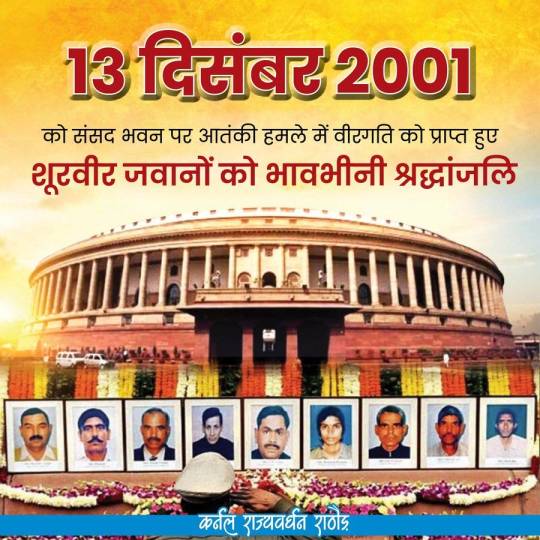
On December 13, 2001, India witnessed one of its darkest days as terrorists attacked the Parliament House in New Delhi. This cowardly act was met with unparalleled bravery by our security personnel, who laid down their lives to protect the nation’s democratic sanctity. On this solemn occasion, Col Rajyavardhan Rathore paid a heartfelt tribute to these heroes, honoring their sacrifice and dedication to the nation.
Remembering the Heroes of the 2001 Parliament Attack
The Parliament attack was a grim reminder of the threats faced by the world’s largest democracy. It was also a moment that showcased the unmatched courage of Indian soldiers and security personnel. Their swift response thwarted a larger catastrophe, preserving the lives of countless leaders and civilians.
Col Rajyavardhan Rathore’s Emotional Tribute
Col Rajyavardhan Rathore, a decorated army officer and Member of Parliament, expressed deep gratitude and respect for the martyred soldiers. He stated: “The bravery and sacrifice of our soldiers during the Parliament attack remain etched in the heart of every Indian. Their valor is a beacon of inspiration for generations to come.”
The Bravehearts We Owe Everything To
The soldiers who sacrificed their lives during the attack include personnel from the Delhi Police, Central Reserve Police Force (CRPF), and the Parliament House Security Service. They stood as the final line of defense, ensuring that India’s democratic foundation remained unshaken.
India’s Response: A Nation United
The attack galvanized India into action, leading to:
Strengthened Counter-Terrorism Measures: Enhanced intelligence-sharing and coordination among security agencies.
Increased Security for Key Installations: Improved infrastructure and surveillance at vital locations.
Global Awareness on Terrorism: India’s firm stance on terrorism resonated globally, highlighting the need for international cooperation.
Honoring Their Sacrifice Every Year
Every December 13, India observes a moment of silence and organizes memorial events to honor the fallen heroes of the Parliament attack. Leaders across political lines and citizens from all walks of life pay homage, ensuring their sacrifice is never forgotten.
Col Rajyavardhan Rathore’s Call to Action
In his tribute, Col Rathore urged citizens to remain vigilant against threats to national security. He emphasized the importance of unity and resilience, encouraging the younger generation to uphold the values that these martyrs fought to protect.
“Their sacrifice reminds us of our duty to contribute to the nation’s strength, unity, and progress,” he said.
Why We Must Never Forget
The Parliament attack was not just an assault on a building but an attack on the ideals of democracy and freedom. Remembering the sacrifice of these soldiers is crucial for:
Inspiring Future Generations: Their bravery serves as a testament to the power of patriotism.
Strengthening National Unity: Honoring martyrs fosters a collective spirit of resilience.
Combating Complacency: Regular remembrance reinforces the need for vigilance against terrorism.
A Legacy of Valor
The brave soldiers who defended India’s Parliament House on that fateful day embody the highest ideals of courage and selflessness. Their sacrifice serves as a reminder of the price of freedom and the duty of every citizen to uphold it. As Col Rajyavardhan Rathore aptly said, “The best way to honor their memory is by building a strong, united, and secure India.”
3 notes
·
View notes
Text
Happy Armed Forces Flag Day: A Tribute by Col Rajyavardhan Rathore

On Armed Forces Flag Day, we pause to honor the valor, dedication, and sacrifices of India’s Armed Forces. Colonel Rajyavardhan Rathore, a decorated soldier himself, extends his heartfelt wishes and gratitude to the brave men and women who protect the sovereignty of our nation.
Armed Forces Flag Day: A Day of Gratitude
Since its inception on December 7, 1949, Armed Forces Flag Day has been a solemn occasion to honor the heroes of our Armed Forces — those who stand guard on borders, protect us in times of need, and embody unparalleled patriotism. It is also a day to raise funds for the welfare of serving personnel, veterans, and their families.
Colonel Rajyavardhan Rathore’s Message
On this special day, Col Rathore expressed: “The Armed Forces are the pillars of our nation’s strength. Their sacrifices ensure our freedom, and it is our duty to recognize and support them. Let’s unite to honor their unmatched courage.”
Why Armed Forces Flag Day Matters
1. Honoring the Sacrifices
Recognizing those who laid down their lives for the nation.
Paying tribute to the families of martyrs who endure untold hardships.
2. Supporting Veterans and Families
Funds raised on this day are used for:
Rehabilitation of injured soldiers.
Welfare of veterans.
Financial aid for the families of fallen heroes.
3. Promoting Patriotism
The day fosters a sense of unity and pride among citizens, reminding us of the debt we owe to our Armed Forces.
Colonel Rajyavardhan Rathore: A Soldier’s Perspective
As a former officer in the Indian Army, Col Rathore understands the life of a soldier firsthand. His journey from the military to public service is a testament to his commitment to the nation and its people. His efforts on Armed Forces Flag Day aim to bridge the gap between civilians and the Armed Forces, urging every citizen to contribute to this noble cause.
How Can We Support the Armed Forces?
1. Contribute to the Armed Forces Flag Day Fund
Donations directly aid soldiers, veterans, and their families.
Even small contributions can make a significant difference.
2. Wear the Flag with Pride
The small Flag Day token symbolizes solidarity and respect for the Armed Forces.
3. Spread Awareness
Encourage others to recognize the importance of this day through social media, events, and local gatherings.
4. Volunteer for Welfare Programs
Many organizations provide avenues to assist veterans and their families.
The Role of Civilians in Supporting the Forces
Col Rathore believes that Armed Forces Flag Day is not just about monetary contributions but also about acknowledging the sacrifices of our soldiers. It’s an opportunity for every citizen to reflect on the freedom and peace we enjoy because of their vigilance and courage.
A Unified Tribute
As we celebrate Armed Forces Flag Day, let us come together to express our gratitude and extend our support to the brave hearts of India. Under the leadership and inspiration of individuals like Col Rajyavardhan Rathore, we can make a meaningful impact in the lives of those who protect our nation.
2 notes
·
View notes
Note
Only a bit from a few very well written tumblr posts. Think you could refresh our memories, General?


YIN YUANSHUAI: "…"

SALIERI: "Aren't you going to tell them?"

YIN YUANSHUAI: "…I'm not used to talking that much… and it's a long story."

SUZUKA: "Ugh. Literally. Fine, I'll tell it. It's not there's a billion variations of the story or whatever. Exposition ahead, I guess."


SUZUKA: "Oh, good. Yeah, that's the guy. That's not what we're focusing on, though. Let's just follow the big details."

Kalmashampada was a king of the legendary Solar Dynasty in India- one of the Suryavamsha, the Descendants of Surya. Some people considered him just, others considered him foolish, and some a mix of both. Regardless, while he was known as an ancestor of the great divine hero Rama, he was also known for being transformed into a man-eating Rakshasa. The reasonings behind this transformation vary, with him bringing the transformation upon himself due to his arrogance, or having it brought upon him through sheer misfortune.
In Japan, King Kalmashampada is known as Hanzoku. There, an extra detail is added that before Hanzoku became king, he was approached by a heretical priest.

The priest promised that if Hanzoku killed 1000 royals and offered their skulls in tribute to the priest's god, his reign would flourish. Hanzoku, eager to have a strong and stable reign, defeated 999 kings and captured them. He captured the 1000th royal, a wise sage who may have been an incarnation of the Buddha himself, who revealed the truth. The god that Hanzoku was about to pay tribute too was a god of death and graves, and no good would come from completing the ritual. The prince, Hanzoku, realizing the errors of his ways, let the men he captured go and was redeemed. The Grave God, enraged at Hanzoku's failure to complete the ritual, transforms into a fox spirit and declares their intent to wreak havoc upon everywhere the Buddha's light shone, cementing themselves as an enemy of good for eternity. There is a variation of this tale, however, that introduces the fox spirit.

Rather than a heretical priest, Hanzoku is driven to darkness by one of his concubines, a mysterious woman named Kayo. Lady Kayo, beautiful and bewitching, convinces Hanzoku to slaughter 1000 men in her name. He does so, his might taking down ruler after ruler, before-- similarly to the first telling-- a sage arrives.
The Lady Kayo had been sequestered away, possibly due to illness, and so the sage approaches and under the guise of healing, reveals the fox spirit. The fox spirit, realizing that her game is over, retreats after briefly terrorizing Hanzoku, and vanishes to another part of Asia.
Legends connect this fox spirit to the spirit Daji, and state that Kayo went on to become the treacherous Bao Si and the accursed Tamamo-no-Mae.
SUZUKA sighed, after recounting everything.

SUZUKA: "…But the details vary from person to person, and most of the records are difficult to uncover. Take what I said with a grain of salt, because these sorts of myths are a lot more complicated than you'd think. This was just the most streamlined way I could put it together without too many 'but maybe's..."

SUZUKA: "It also brings up the question. Are the ancient Grave God and Lady Kayo the same being? Is this ancient god of burial and death associated with the fox demons that terrorized various dynasties? Looking at the hellish world we're in, I'm guessing at least the Priestess thinks so."

SALIERI: "Was there a point to this?"

YIN YUANSHUAI: "Perspective, mostly. It's best to know your enemy. Knowing more than just Hanzoku's name could offer a path to success..."
6 notes
·
View notes
Text
Independence Day Speech 2024
Independence Day 2024 Speech
Respected principal, teachers and my dear friends, today, we gather here to celebrate the 78th Independence Day of our nation. As we observe the anniversary of the liberation of our nation from British colonial rule, our hearts are filled with pride and gratitude for the sacrifices of our freedom fighters who fought bravely for our liberty and our rights.
The British ruled our nation for 200 years. They had come to India for trade and commerce but instead, they looted India and exploited its people. India became an independent country on August 15, 1947, because our ancestors fought for centuries.
Independence Day Speech 2024 in 200 Words
Respected principal, teachers and my dear friends, Independence Day is celebrated on August 15. This day marks the nation’s liberation from the British colonial rule after a long struggle. On this day, we pay tribute to the brave souls who laid down their lives and fought valiantly for the freedom we cherish today. Independence Day is a solemn occasion of national pride and unity.
Independence Day is a glorious occasion when people come together to cherish the journey of our nation and pledge to uphold the values of justice, liberty and equality. As a nation, our unity and diversity are our greatest strengths. The freedom that we enjoy today came as a result of the sacrifices of our valiant freedom fighters.
This freedom was achieved after countless movements such as the Civil Disobedience movement. The nation would not have attained independence, had it not been for notable freedom fighters like Mahatma Gandhi, Jawaharlal Nehru, Netaji Subhash Chandra Bose, Lala Lajpat Rai, Bal Gangadhar Tilak, Sardar Vallabhbhai Patel, Gopal Krishna Gokhale, Lokmanya Bal Gangadhar Tilak and many others.
On this Independence Day, let us come together to cherish this occasion and work towards building a nation which is united and democratic.
3 notes
·
View notes
Text
Gandhi Jayanti
On this Gandhi Jayanti, UBS Villas pays tribute to Mahatma Gandhi, the father of our nation, whose values of simplicity, truth, and non-violence continue to inspire millions. Just as Gandhi envisioned a peaceful and self-sustained India, UBS Villas strives to create homes that reflect harmony, sustainability, and quality living. As we honor his legacy, let us also reflect on how we can incorporate his values into our modern lives. Here’s to building a better tomorrow, together.
Happy Gandhi Jayanti!
#Gandhiji#mahatma gandhi#gandhi jayanti#ubsvillas#fatherofnation#villas#best villa in palakkad#gatedcommunity#oct2
2 notes
·
View notes
Text

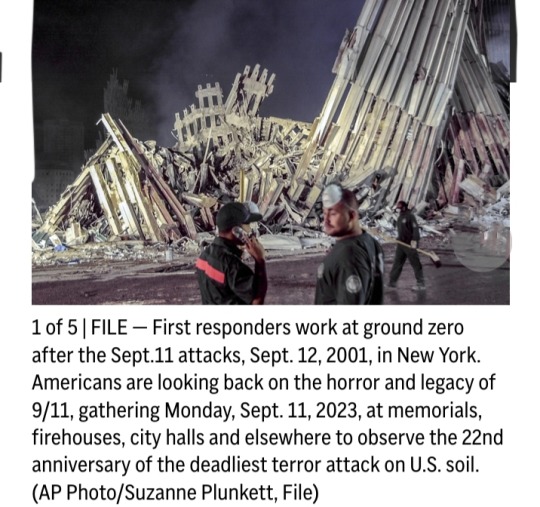
By JENNIFER PELTZ
September 11, 2023
NEW YORK (AP) — Americans are looking back on the horror and legacy of 9/11, gathering Monday at memorials, firehouses, city halls and elsewhere to observe the 22nd anniversary of the deadliest terror attack on U.S. soil.
Commemorations stretch from the attack sites — at New York’s World Trade Center, the Pentagon and Shanksville, Pennsylvania — to Alaska and beyond.
President Joe Biden is due at a ceremony on a military base in Anchorage.
His visit, en route to Washington, D.C., from a trip to India and Vietnam, is a reminder that the impact of 9/11 was felt in every corner of the nation, however remote.
The hijacked plane attacks claimed nearly 3,000 lives and reshaped American foreign policy and domestic fears.
"On that day, we were one country, one nation, one people, just like it should be. That was the feeling — that everyone came together and did what we could, where we were at, to try to help,” said Eddie Ferguson, the fire-rescue chief in Virginia’s Goochland County.
It’s more than 100 miles (160 kilometers) from the Pentagon and more than three times as far from New York.
But a sense of connection is enshrined in a local memorial incorporating steel from the World Trade Center’s destroyed twin towers.
The predominantly rural county of 25,000 people holds not just one but two anniversary commemorations: a morning service focused on first responders and an evening ceremony honoring all the victims.
Other communities across the country pay tribute with moments of silence, tolling bells, candlelight vigils and other activities.
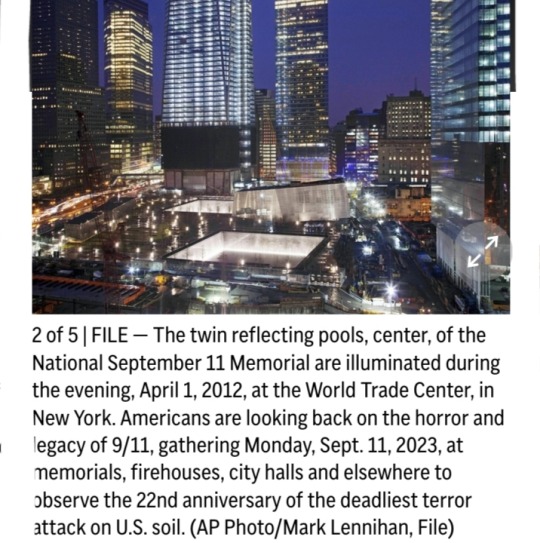
In Columbus, Indiana, 911 dispatchers broadcast a remembrance message to police, fire and EMS radios throughout the 50,000-person city, which also holds a public memorial ceremony.
Boy Scouts and Girl Scouts raise and lower the flag at a commemoration in Fenton, Missouri, where a “Heroes Memorial” includes a piece of World Trade Center steel and a plaque honoring 9/11 victim Jessica Leigh Sachs.
Some of her relatives live in the St. Louis suburb of 4,000 residents.
“We’re just a little bitty community,” said Mayor Joe Maurath, "but it’s important for us to continue to remember these events. Not just 9/11, but all of the events that make us free.”
New Jersey’s Monmouth County, which was home to some 9/11 victims, made Sept. 11 a holiday this year for county employees so they could attend commemorations.

As another way of marking the anniversary, many Americans do volunteer work on what Congress has designated both Patriot Day and a National Day of Service and Remembrance.
At ground zero, Vice President Kamala Harris is due to join the ceremony on the National September 11 Memorial & Museum plaza.
The event will not feature remarks from political figures, instead giving the podium to victims’ relatives for an hourslong reading of the names of the dead.
James Giaccone signed up to read again this year in memory of his brother, Joseph Giaccone, 43. The family attends the ceremony every year to hear Joseph’s name.
“If their name is spoken out loud, they don’t disappear,” James Giaccone said in a recent interview.
The commemoration is crucial to him.
“I hope I never see the day when they minimize this,” he said. “It’s a day that changed history.”

Biden, a Democrat, will be the first president to commemorate Sept. 11 in Alaska, or anywhere in the western U.S.
He and his predecessors have gone to one or another of the attack sites in most years, though Republican George W. Bush and Democrat Barack Obama each marked the anniversary on the White House lawn at times.
Obama followed one of those observances by recognizing the military with a visit to Fort Meade in Maryland.
First lady Jill Biden is due to lay a wreath at the 9/11 memorial at the Pentagon.
In Pennsylvania, where one of the hijacked jets crashed after passengers tried to storm the cockpit, a remembrance and wreath-laying is scheduled at the Flight 93 National Memorial in Stoystown operated by the National Park Service.
Harris’ husband, Doug Emhoff, is expected to attend the ceremony.
The memorial site will offer a new educational video, virtual tour and other materials for teachers to use in classrooms.
Educators with a total of more than 10,000 students have registered for access to the free “National Day of Learning” program, which will be available through the fall, organizers say.
“We need to get the word out to the next generation,” said memorial spokesperson Katherine Hostetler, a National Park Service ranger.

#9/11#New York#Twin Towers#World Trade Center#Pentagon#Pennsylvania#hijacked plane attacks#Heroes Memorial#Patriot Day#National Day of Service and Remembrance#Flight 93 National Memorial#National Park Service#National Day of Learning#National September 11 Memorial & Museum#11 September 2001#United States#terrorist attack#terror attack
16 notes
·
View notes
Text
BEST DIRECTORS IN CINEMA-3
Hi everyone! This blog is going to be the 3rd part of 8 Part Series of who I think are the Best Directors Cinema as ever seen
And today I will be talking about
SATYAJIT RAY
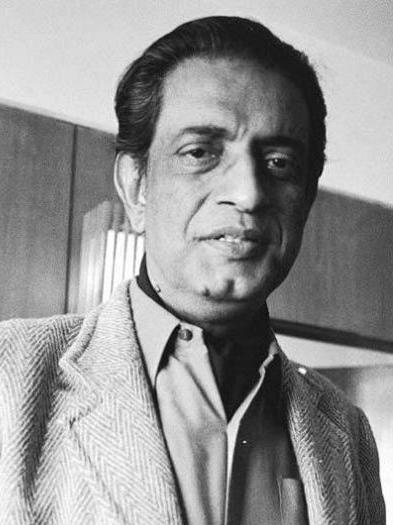
Satyajit Ray (born May 2, 1921, Calcutta [now Kolkata], India—died April 23, 1992, Calcutta) was a Bengali motion-picture director, writer, and illustrator who brought the Indian cinema to world recognition with Pather Panchali (1955; The Song of the Road) and its two sequels, known as the Apu Trilogy. As a director, Ray was noted for his humanism, his versatility, and his detailed control over his films and their music. He was one of the greatest filmmakers of the 20th century.
(Early Life)
Ray was an only child whose father died in 1923. His grandfather was a writer and illustrator, and his father, Sukumar Ray, was a writer and illustrator of Bengali nonsense verse. Ray grew up in Calcutta (now Kolkata) and was looked after by his mother. He entered a government school, where he was taught chiefly in Bengali, and then studied at Presidency College, Calcutta’s leading college, where he was taught in English. By the time he graduated in 1940, he was fluent in both languages. In 1940 his mother persuaded him to attend art school at Santiniketan, Rabindranath Tagore’s rural university northwest of Calcutta. There Ray, whose interests had been exclusively urban and Western-oriented, was exposed to Indian and other Eastern art and gained a deeper appreciation of both Eastern and Western culture, a harmonious combination that is evident in his films.
(His Famous Works)
Ray's first film, Pather Panchali (1955) won eleven international prizes, including the inaugural Best Human Document award at the 1956 Cannes Film Festival. This film, along with Aparajito (1956) and Apur Sansar (The World of Apu) (1959), form The Apu Trilogy. Ray did the scripting, casting, scoring, and editing, and designed his own credit titles and publicity material. He also authored several short stories and novels, primarily for young children and teenagers. Popular characters created by Ray include Feluda the sleuth, Professor Shonku the scientist, Tarini Khuro the storyteller, and Lalmohan Ganguly the novelist.
(Filmmaking Style)
His Filmmaking
Ray had been subconsciously paying a tribute to Jean Renoir throughout his career, who influenced him the most.Ray considered script-writing to be an integral part of direction. Initially he refused to make a film in any language other than Bengali. In his two non-Bengali feature films, he wrote the script in English; translators adapted it into Hindustani under Ray's supervision.The narrative structure of Ray's films are represented by musical forms such as sonata, fugue and rondo. Kanchenjunga, Nayak and Aranyer Din Ratri are examples of this structure.
(His Filmography)
Ray made over 36 feature film in his 4 decade long. He made movies such as Pather Panchali in 1955,Aparajito in 1956,Parash Pathar and Jalsaghar in 1958, Apur Sansar in 1959, Devi in 1960. He made movies such as Teen Kanya in 1961, Kanchenjungha and Abhijan in 1962,Mahanagar in 1963,Charulata and Two I'm 1964,Kapurush-0-Mahapurush in 1965,Nayak in 1966,Chiriyakhana in 1967,Goopy Gyne & Bagha Byne in 1969,Aranyer Din Ratri and Pratiwandi in 1970, Seemabaddha and Sikkim in 1971,Inner Eyes in 1972,Ashani Sanket in 1973,Sonar Kella in 1974,Jana Aranyw in 1975,Bala in 1976,Shatranj ka Khilari in 1977,Joi Baba Felunath in 1979,Hirak Rajar Deshe and Pikoo in 1980,Sadgati in 1981,Ghare Bhare in 1984,Sukumar Ray in 1987,Ganashatru and Shakha Proshakha in 1990,Agantuk in 1990.
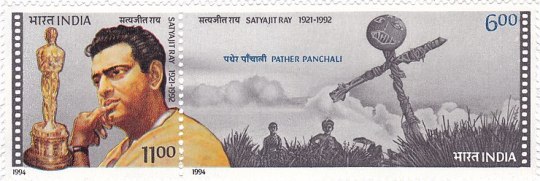
Satyajit Ray on 1994 stamp of India
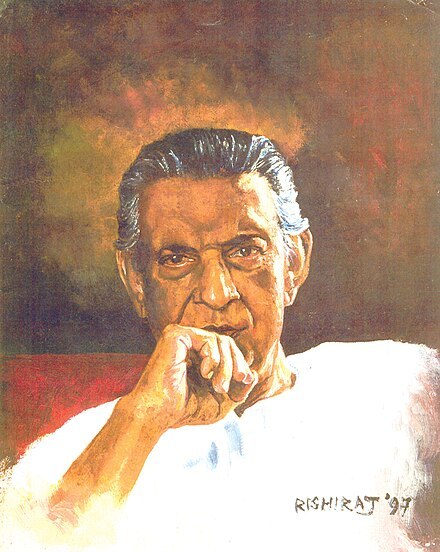
Portrait of Satyajit Ray
(Awards & Honors)
Ray received many awards including 36 National Film Awards. He was awarded the Dadasaheb Phalke Award in 1985 and Legion Of Honor in 1987. The Government of India also awarded him with Padma Bhusan in 1965. He also received a Lifetime Achievement Award in 1992 at the Academy of Motion Pictures Arts and Sciences. He also won the Golden Lion at the Venice Film Festival
(Legacy)
Ray is considered one of the greatest film directors of all time. He is a cultural icon in India and in Bengali communities worldwide. Following his death, the city of Calcutta came to a virtual standstill, as hundreds of thousands of people gathered around his house to pay their last respects. Ray's influence has been widespread and deep in Bengali cinema; many Bengali directors, including Aparna Sen, Rituparno Ghosh and Gautam Ghose as well as Vishal Bhardwaj, Dibakar Banerjee, Shyam Benegal and Sujoy Ghosh from Hindi cinema in India, Tareq Masud and Tanvir Mokammel in Bangladesh, and Aneel Ahmad in England, have been influenced by his craft.Beyond India, filmmakers Martin Scorsese, Francis Ford Coppola, George Lucas, James Ivory, Abbas Kiarostami, Elia Kazan, William Wyler,François Truffaut, John Huston, Carlos Saura, Isao Takahata, Oliver Stone,Quentin Tarantino, Wes Anderson,Danny Boyle and Christopher Nolan.
(Sources)
And that's it for this part folks, I'll meet you with another blog about some the Greatest Directors Cinema has ever seen, Until then
CIAO
3 notes
·
View notes
Text

Today, on the birth anniversary of #ManmohanDesai, let's celebrate the life and work of one of the greatest filmmakers in Indian cinema. Desai was a pioneer of the masala genre, known for his entertaining and larger-than-life movies that defined Hindi cinema in the 1970s and 80s.
Desai was a master of blending different genres, from action and drama to romance and comedy and creating unforgettable cinematic experiences for audiences. His films were known for their extravagant sets, catchy music, and larger-than-life characters that captured the imagination of viewers across India.
Desai's legacy as a filmmaker continues to inspire generations of filmmakers today. His movies remain timeless classics that are cherished by audiences of all ages. He was a true legend of Indian cinema who will always be remembered for his contribution to the art form.
On this special day, let's pay tribute to Manmohan Desai and his incredible body of work. Happy birthday, sir! Your legacy lives on.
5 notes
·
View notes